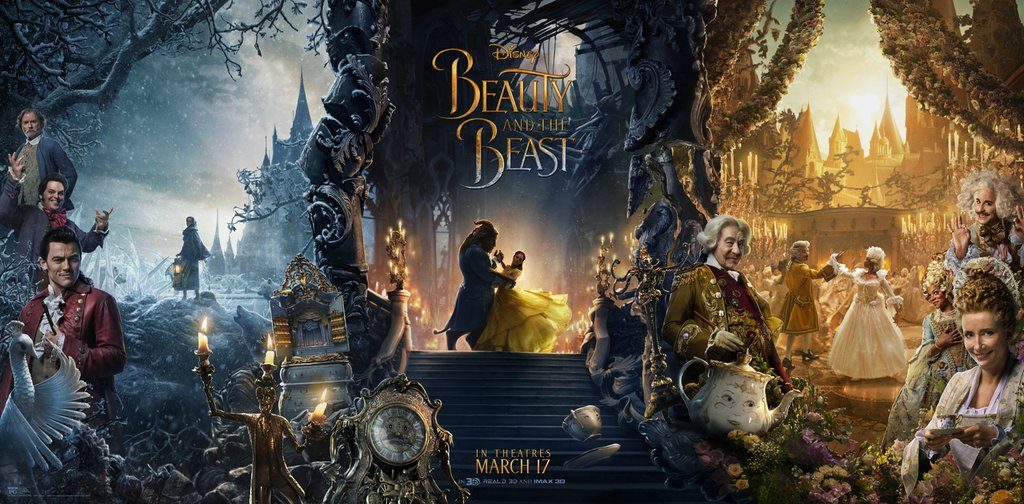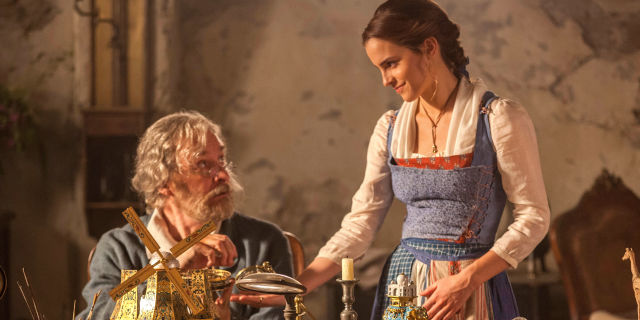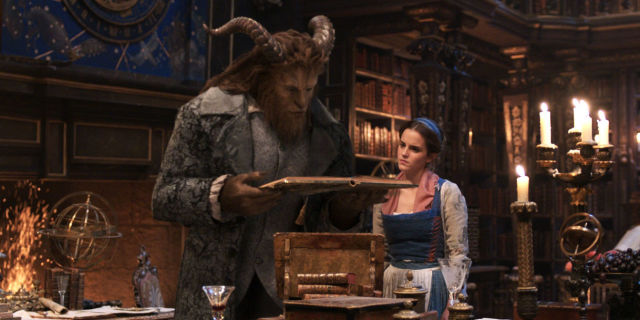After bringing their animated classics Cinderella and The Jungle Book back to cinemas as CGI-soaked live-action films, Disney has now begun the much more intimidating task of shooting remakes of their revered classics from the 1990s—a time period often referred to as The Disney Renaissance. The first to make this transition is 1991’s beloved Beauty and the Beast, originally directed by Gary Trousdale and Kirk Wise, and here remade by Bill Condon (Dreamgirls, The Fifth Estate). Crediting the directors of the 1991 animated film is essential, because, not unlike Zack Snyder’s film adaptation of Watchmen, the 2017 Beauty and the Beast is more of a translation than it is an adaptation, which makes it nearly impossible to talk about without comparing it to its inspiration. And while it’s unlikely to replace its predecessor in anyone’s hearts, there is some value to be found in this new expanded version.
I’d like to apologize in advance for any new elements found in this film that were actually added for the Broadway musical adaptation that premiered in 1994—like most of the audience for the new Beauty and the Beast, I haven’t seen it. Apart from that, I saw Beauty and the Beast under ideal conditions: in 3D, with my mother. If that’s an option available to you, I recommend it.
You’ve likely already seen about 70% of this movie—nearly every beat from the 1991 film exists in the remake, some reproduced exactly and some expanded or reimagined. You know the story—a young woman (Emma Watson) living a dull existence in a small French village is held captive in a castle, where a selfish prince (Dan Stevens) is cursed to live as a ghoulish hairy beast unless he can find true love and have that love returned. The Beast’s servants are desperate to get the two kids together, so they, too, can shake the spell that’s transformed them into decreasingly anthropomorphic household objects. Despite the extremely messed up circumstances of their meeting, romance blossoms, but that relationship is threatened by the handsome but vicious Gaston (Luke Evans), who leads an angry mob to the Beast’s door.
The remaining 30% amounts to what feels like extended or deleted scenes from the original, expanding on the characters and adding a few songs. Both Belle and the Beast benefit from the extra time to develop as individuals—Belle and her father Maurice (Kevin Kline) left Paris after Belle’s mother was stricken with the plague, further explaining her outsider status in the village; Beast also lost a parent at a young age, but his widower father was the virtual opposite of Maurice, leading to his sour selfish demeanor. The romantic montage from the original film during which Belle and Beast go from adversaries to friends is expanded to a full act of the film, showing the two of them bonding over their mutual love of literature and their lifelong loneliness. As a result, the new Beauty and the Beast, while not totally shaking the creepy Stockholm Syndrome feeling that’s deeply imbedded in the original fairy tale, is a more effective love story than the animated version.
Belle is a far more active a character in this Beauty and the Beast, in both obvious and more subtle ways. The obvious—the reason this Belle takes the place of her father in the Beast’s dungeon is that she’s far more likely to escape than he is, and she creates numerous opportunities to leave the castle that she chooses for one reason or another not to pursue. The subtle—when she tells the Beast to step into the light when they first meet, he doesn’t move, so she just steps up to him with the lamp instead. (Poor editing robs this moment of its gravity, but on paper, it’s a win for Belle.) She’s still a flatly heroic character with no real flaws to speak of, but this is a film for children, and Belle is a terrific example of a fearless and compassionate young woman who’s willing to fight for herself, for her family, and even for the little girl in the village who no one else will teach to read. Though there’s nothing terribly demanding about the role (apart from the crushing pressure of bringing such a beloved character to life on screen), a subplot about Belle wanting to learn more about her mother’s death gives Emma Watson a little something to chew on as an actress.
Dan Stevens has the more difficult task in the film, having to carefully measure how much the audience ought to dislike or sympathize with the Beast at any given time. His voice and motion capture performance shine through despite the uninspired and unconvincing CGI Beast model. He’s even gifted his own song, “Evermore,” which gives Beast a redemptive moment lacking in the original—rather than quietly brooding after he frees Belle so she can rescue her father, Beast pledges to remember Belle and not to slip back into his old selfish ways, even if she never returns. The song itself doesn’t match the quality of the originals, mostly because lyricist Tim Rice is a poor substitute for the late Howard Ashman, but it’s a welcome story beat.
The song performances are where the new Beauty and the Beast fluctuate most in quality. Emma Watson, cast for her acting and her movie star recognizability, is not a Broadway-caliber vocalist, and her performances on this soundtrack are auto-tuned to death. Dan Stevens may also benefit from pitch-correction, but it’s less noticeable because the Beast’s voice is always modulated while he’s transformed. Kevin Kline (Maurice) and Josh Gad (LeFou) are adequate vocalists. Of the live-action performers, it was Luke Evans as Gaston who shined most brightly in the musical numbers, which took me off guard—evidently before Evans was appearing in mediocre fantasy-action films like The Hobbit and Dracula Untold, he was starring in Rent on the West End. But apart from Evans and Emma Thompson, most of the marquee names in this film don’t do justice to Alan Menken’s music.
This is a common issue with movie adaptations of musicals, prioritizing movie star power over the technical musical abilities necessary to perform the songs as written, and Beauty and the Beast compounds this issue with unnecessary stunt voice casting, as well. Ewan McGregor is a terrific actor, but he struggles to strike the right level of silly in his voice performance as Lumière—this is the sort of thing veteran voice actors excel at. McGregor appears in the flesh only for the final two minutes of the film, so his presence in Beauty & the Beast is essentially so they can put him on the poster. Why does Stanley Tucci play the harpsichord? I love Stanley Tucci, but he’s a complete waste here. How many more butts is Stanley Tucci as the harpsichord really putting in the seats? Emma Thompson as Mrs. Potts and Sir Ian McKellan as Cogsworth are exceptions, as they absolutely hold their weight, though Thompson is essentially reprising Angela Lansbury’s animated performance pitch for cockney pitch. Thankfully, Tony Award-winner Audra McDonald gets to show off her operatic prowess as Madame de Garderobe—props to her and to whoever said “enough is enough” and didn’t cast, like, Melissa McCarthy in that role.
The new Beauty and the Beast at its strongest when it’s breaking new ground, but it’s at its weakest when it directly apes the original film. With a few exceptions, any time Condon attempts to reproduce a shot or a moment from the animated film, it comes across as phony or dizzying. Belle’s hilltop twirl at the climax of her eponymous “want song” is a hideously fake-looking green screen effect in the new film, and “Be Our Guest” ratchets the giddiness of the original until it becomes physically difficult to follow in its intended 3D. While most of the film set outside of the Beast’s enchanted castle feels fairly grounded and realistic, Belle still talks to her horse Philippe like he’s an emotive cartoon character rather than as a horse, and it feels out of place. No alterations are made to the design of the Beast himself, and as a result he doesn’t quite read as scary in a live-action world.
But even after all of this criticism, I do have to confess that, on the whole, I did like this film, even if I found the first half in particular to be disappointing. It’s not even remotely a better movie than the 1991 version, but there are things that are better about it. The love story is an improvement on the original, Gaston is an entertaining but threatening villain, and the final twenty minutes are tight. I find myself fixated on details that are really cool, like the higher stakes for the transformed servants, whose transformation into lifeless objects will be complete when the spell’s time limit runs out, essentially killing them, or even just the subtle touch of an antler-like ornament on Belle’s ear when she wears the iconic gold dress from the ballroom sequence, which feels like a small token of her affection for the Beast. I liked meeting the Prince, in eerie and extravagant makeup, before his transformation. And I liked this most of all—in the beginning of both films: Belle sings “For once it might be grand/ to have someone understand/ I want so much more than they’ve got planned,” and in this version far more than the original, I feel like Belle actually has gotten what she asked for.
Beauty and the Beast is in theaters now.




